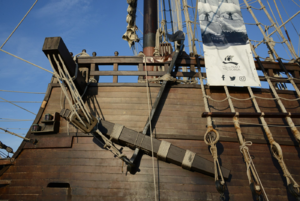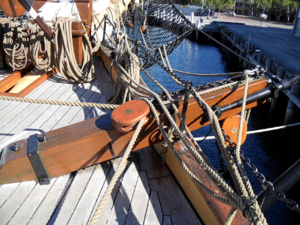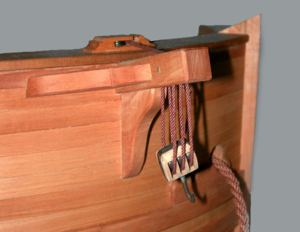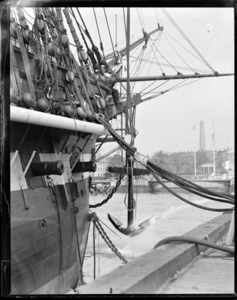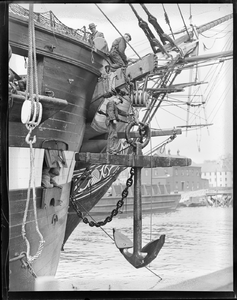-
LUCZORAMA SHIPWRECK SCAVENGER HUNT GIVEAWAY. 4 Weeks of Fun • 1 Legendary Prize ((OcCre’s Fram Ship)) • Global Crew Welcome!
**VIEW THREAD HERE**
You are using an out of date browser. It may not display this or other websites correctly.
You should upgrade or use an alternative browser.
You should upgrade or use an alternative browser.
They are great photos Jim, thanks for sharing.
the last picture looks quite "creative" 
Fabulous photos I have learnt heaps
Hello Markus, This is real photo from USS Constitution. Take a look herethe last picture looks quite "creative"
Home - USS Constitution Museum
How would they get the hook of the cathead tackle into the anchor loop? Someone in a small boat?
* taken from Quora.comHow would they get the hook of the cathead tackle into the anchor loop? Someone in a small boat?
A ship normally had several anchors of different sizes for use in various circumstances, but the main ones used were the two 'bower anchors' which hung either side of the ship's bow. By convention, these anchors weighed 1/500 of the ship's tonnage: a large ship's anchor of the 1660s weighed over three tons.
The main anchor was normally lashed to the ship's side when at sea, held horizontally. The first step in preparing to anchor was therefore to unfasten it and allow it to swing down into a vertical position, dangling by a short rope called the stopper from a projecting timber beam called the cathead.
The term 'cathead' is recorded from the 17th century onwards. Supposedly the end of the beam was often carved into the shape of a cat's head, but that may just be folk etymology.
A hawser would meanwhile be brought up onto deck from its storage down in the cable locker in the orlop. Standard practice was to use a cable that was three times longer than the depth of the water. This cable would be fastened to the ship's frame at one end, to two strong projecting timbers in the deck called the bitts, or bitt-heads. The cable was then laid out along the length of the deck in loops so it could run out freely. The other end would be passed through the hawser hole in the side of the ship and fastened to the loop at the top of the anchor. This hawser hole was usually plugged while at sea to prevent water entering through it, so the plug would first have to be removed.
An anchor buoy was often attached to the anchor before it was dropped. This was essentially a small waterproofed wooden barrel, lashed around with ropes and tied to the anchor's crown by another long rope. When the anchor was dropped, this buoy would float on the surface directly above it, alerting other ships to the position of the anchor and preventing them from fouling the anchor cable.
With the anchor and cable ready, the ship would sail into position - sensible captains took it slowly, show-offs sailed into the harbour at full speed then struck sail and dropped anchor at the last minute, coming to a stop with a jerk.
To drop anchor, the rope stopper attaching the anchor to the cathead would be unfastened, and the anchor would splash down into the sea then sink to the bottom, pulling the cable behind it. A ship would normally drop anchor upwind, upside or upstream of the point where it actually wanted to rest and would drift slowly downwind as the cable paid out through the hawser hole until it was at full extension.
Because the component of the ship that the anchor cable was attached to was called the bitts, sailors referred to the part of the cable that remained inside the ship after the rest of it had been run out as the 'bitter end'. It's unknown if the expression 'reaching the bitter end' originated here, or if it was already in use and was adopted by sailors as a pun.
Dropping a single anchor was something only done if the ship was making a brief stop because if the wind and tides changed the ship would swing in a wide circle around its anchor. For longer stops, two anchors were used - this was referred to as 'mooring' the ship. The first anchor would be dropped as described above, then the ship allowed to drift (or possibly, sailed under very light sail) until the cable was at full extension. The second anchor would then be dropped. Finally, the sailors would use the capstan to reel in the first cable, pulling the ship along with it towards the anchor, until the ship was positioned midway between the two anchors.
Operating a capstan was a major job. A typical warship of the 1660s might have eight men on each of four bars of the capstan, total 32. A century later a 12-bar capstan might need a hundred men to operate it on the largest ships.
It was also possible to take out an anchor in a small boat. This was a complicated procedure: the anchor would have to be hauled up into the ship's rigging using a block and tackle, swung over the side of the ship, and carefully lowered into the water alongside one of the ship's boats. The anchor ring would be attached to the stern of the boat, and its crown pulled up against the bottom of the boat so the anchor was, in effect, slung underneath it in the water.
The boat would then be rowed out away from the ship, paying out the anchor cable behind it. When it reached the right distance the anchor would be released, hopefully without swamping the boat or dragging it under. This was a way to get an anchor the right distance away from the ship if there was no wind or current to allow it to drift down in the usual way.
It was most useful for 'kedging' - a way to move a sailing ship in shallow water in the absence of wind. A small anchor (called a kedge-anchor) would be rowed away from the ship and dropped to the seabed. The sailors would then haul on the anchor cable, pulling the ship in the direction of the anchor. Once they were too close for this to work, the anchor would be hauled up and the whole process repeated. This was painfully slow and exhausted the crew, but in the days before engines, it was often the only way to leave port if there was a contrary wind.
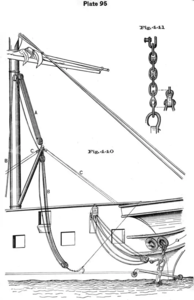
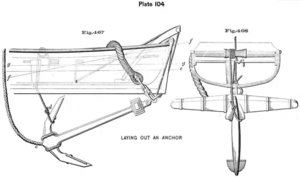
Avery interesting and informative reading, almost everything about the anchors
Enjoy
Here is another educational material
Here's a simple anchor setup, port & starboard, one up and one down of my recently completed Constellation.
Great book btw. Just last week, after replacing the broken jib boom on her, I was retelling my son of an incident I read in Six Frigates between the Constitution and the Philadelphia (I think) where their bowsprits got tangled doing a crossing maneuver in the Mediterranean. This maneuver was a greeting of sorts gone wrong due to loss of wind.
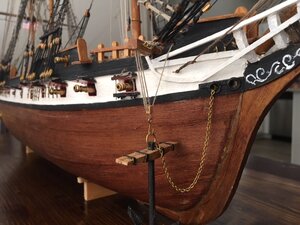
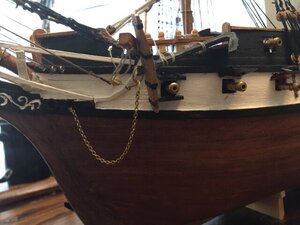
Great book btw. Just last week, after replacing the broken jib boom on her, I was retelling my son of an incident I read in Six Frigates between the Constitution and the Philadelphia (I think) where their bowsprits got tangled doing a crossing maneuver in the Mediterranean. This maneuver was a greeting of sorts gone wrong due to loss of wind.


- Joined
- Apr 20, 2020
- Messages
- 313
- Points
- 278

After much thought and considering the many helpful tips in this thread, I decided to work within my limited experience and lack of appropriate parts for the sheaves, and just do a simplified newbie installation of the anchor and cathead. I know it's not technically the correct way of doing it but I tried to incorporate as much of the functional requirements as I could.
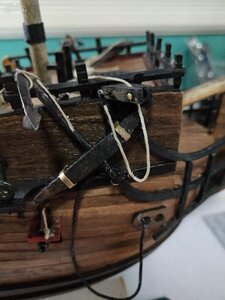
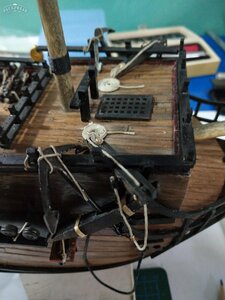
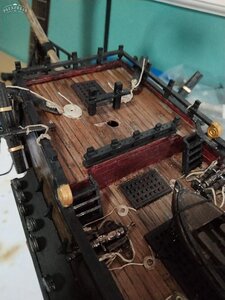
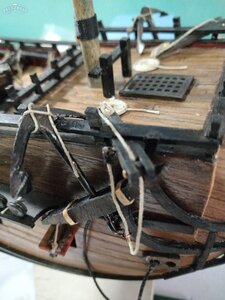




Good job, Reggie! What did you use for blocks for your guns?
- Joined
- Apr 20, 2020
- Messages
- 313
- Points
- 278

Hi Vic @Vfordyce ....after much thought, as I explained in my Black Pearl build log, I decided to not put any blocks on my tackle ropes...I didn't have blocks that were small enough...the ones that I did have were disproportionately too large...I felt that to most observers, they will more likely notice the too large blocks than the absence of them.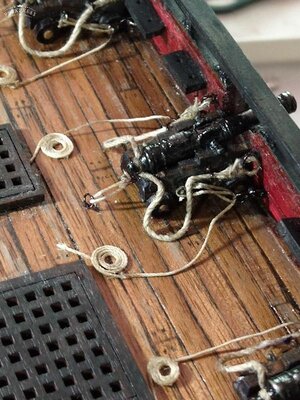
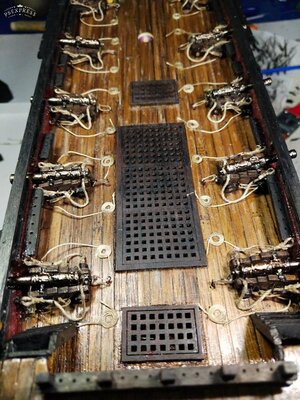
Hope this helps.


Hope this helps.
I would tend to agree at that scale. I just used a big restraining rope for the cannons on my Connie.Hi Vic @Vfordyce ....after much thought, as I explained in my Black Pearl build log, I decided to not put any blocks on my tackle ropes...I didn't have blocks that were small enough...the ones that I did have were disproportionately too large...I felt that to most observers, they will more likely notice the too large blocks than the absence of them.View attachment 185294
View attachment 185295
Hope this helps.
As I know the carriage side tackle was for outhaul only, not breach hawser restraint which passed through the carriage sides an was eyespliced to iron eyebolts in the bulkhead. The inhaul tackle to bring it back in for the reloading process was much more simple depending upon the weight of the gun which for a 32 pounder was around 5,500 lbs and took a significantly sized/manned gun crew setting the distance between gun stations for working room.I would tend to agree at that scale. I just used a big restraining rope for the cannons on my Connie.
The traditional gun commands were:
Draw back, Out Tampions, Load powder. Load wads. Load shot. Load wads. Ram home. Out guns. Aim guns. Prick cartridge. Clear away. Fire!
After firing with the gen carriage inboard from recoil:
Stop vents. Worm. Swab. Load powder, Load wads. Load shot. Load wads. Ram home. Out guns. Aim guns (windage and elevation changes). Prick cartridge. Clear away. Fire!
The number of gun crewmen varied with caliber but the assigned duties were carried out individually or some by the same crewman all under the Gun Captain. Noise and smoke added to the need for attention and clear working space at each station.
In the builds it seems that there is insufficient space given for the gun-crew and their actions with the tackle and falls associated in the operation. Just some thoughts. PT-2
I simplified the full set of commands that Jean Boudriot includes in one of his four volume set, under "Gunnery - The Crew at Work". pp 123 - 32. My addition here is that he identified gun crews on his 84 gun ship as: 36-pounder - 14 men, 18-pounder - 9 men, 8-pounder - 5 men, all not including the powder monkey and those boys carrying up additional shot. Lots of moving around! PT-2As I know the carriage side tackle was for outhaul only, not breach hawser restraint which passed through the carriage sides an was eyespliced to iron eyebolts in the bulkhead. The inhaul tackle to bring it back in for the reloading process was much more simple depending upon the weight of the gun which for a 32 pounder was around 5,500 lbs and took a significantly sized/manned gun crew setting the distance between gun stations for working room.
The traditional gun commands were:
Draw back, Out Tampions, Load powder. Load wads. Load shot. Load wads. Ram home. Out guns. Aim guns. Prick cartridge. Clear away. Fire!
After firing with the gen carriage inboard from recoil:
Stop vents. Worm. Swab. Load powder, Load wads. Load shot. Load wads. Ram home. Out guns. Aim guns (windage and elevation changes). Prick cartridge. Clear away. Fire!
The number of gun crewmen varied with caliber but the assigned duties were carried out individually or some by the same crewman all under the Gun Captain. Noise and smoke added to the need for attention and clear working space at each station.
In the builds it seems that there is insufficient space given for the gun-crew and their actions with the tackle and falls associated in the operation. Just some thoughts. PT-2


